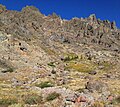Reynolds Peak (California)
| Reynolds Peak | |
|---|---|
 Northeast aspect, from PCT | |
| Highest point | |
| Elevation | 9,690 ft (2,954 m)[1][2] |
| Prominence | 760 ft (232 m)[3] |
| Parent peak | Peak 9860[4] |
| Isolation | 1.30 mi (2.09 km)[4] |
| Coordinates | 38°34′50″N 119°50′19″W / 38.5806389°N 119.8385678°W[5] |
| Naming | |
| Etymology | G. Elmer Reynolds.[6] |
| Geography | |
| Location | Mokelumne Wilderness |
| Country | United States of America |
| State | California |
| County | Alpine |
| Parent range | Sierra Nevada |
| Topo map | USGS Ebbetts Pass |
| Geology | |
| Rock age | Late Tertiary[8] |
| Rock type | Volcanic rock[7] |
| Climbing | |
| Easiest route | class 3 scrambling[4] |
Reynolds Peak is a 9,690-foot-elevation (2,954 meter) mountain summit located in Alpine County, California, United States.
Description
Reynolds Peak is set three miles (4.8 km) northwest of Ebbetts Pass in the Mokelumne Wilderness, on the common boundary that Humboldt–Toiyabe National Forest shares with Stanislaus National Forest. Reynolds Peak is situated on the crest of the Sierra Nevada mountain range, with precipitation runoff from the peak draining west to the North Fork Mokelumne River, and east into tributaries of the East Fork Carson River. Topographic relief is modest as the east aspect rises 1,100 feet (340 meters) above Raymond Meadows in one-half mile. Neighbors include Raymond Peak 1.7 miles (2.7 km) to the north and Highland Peak, 5.1 miles (8.2 km) southeast. The Pacific Crest Trail traverses the eastern base of the mountain, providing an approach option from Ebbetts Pass.
Etymology

At the recommendation of the US Forest Service, this landform's toponym was officially adopted in 1929 by the U.S. Board on Geographic Names to honor Gilbert Elmer Reynolds (1884–1928), for many years the managing editor of the Stockton Record and an advocate of forest conservation.[5] He was a member of the Sierra Club and one of California's leading conservationists.[9][10] He died at his office on July 21, 1928, of a heart attack at age 44, and was buried at the Stockton Rural Cemetery.[11][12]
Climate
According to the Köppen climate classification system, Reynolds Peak is located in an alpine climate zone.[13] Most weather fronts originate in the Pacific Ocean and travel east toward the Sierra Nevada mountains. As fronts approach, they are forced upward by the peaks (orographic lift), causing them to drop their moisture in the form of rain or snowfall onto the range.
Gallery
See also
References
- ^ Peter Browning, Place Names of the Sierra Nevada: From Abbot to Zumwalt, 1986, Wilderness Press, ISBN 9780899970479, p. 182
- ^ United States Board on Geographic Names (1979), Decisions on Geographic Names in the United States, List 7902, Department of the Interior, p. 8
- ^ "Reynolds Peak, California". Peakbagger.com. Retrieved 2022-07-17.
- ^ a b c "Reynolds Peak - 9,700' CA". listsofjohn.com. Retrieved 2022-07-17.
- ^ a b "Reynolds Peak". Geographic Names Information System. United States Geological Survey, United States Department of the Interior. Retrieved 2022-07-17.
- ^ Erwin G. Gudde, William Bright (2010), California Place Names: The Origin and Etymology of Current Geographical Names, University of California Press, ISBN 9780520266193, p. 315.
- ^ Vicky Spring (2004), 100 Hikes in California's Central Sierra and Coast Range, 2nd Ed., The Mountaineers Books, ISBN 9781594851902, p. 50
- ^ David A. John (1984), U.S. Geological Survey Professional Paper, Issue 1300, Part 1, U.S. Government Printing Office, p. 235
- ^ United States Board on Geographic Names (June 5, 1929), Decisions on Geographic Names in the United States, p. 4
- ^ Sierra Club Bulletin (1928), Volume 13, p. 128
- ^ Jack Jacobs, Recordnet.com, July 4, 2004
- ^ Gilbert Elmer Reynolds, Findagrave.com
- ^ "Climate of the Sierra Nevada". Encyclopædia Britannica.
External links
- Weather forecast: Reynolds Peak
- Gilbert Elmer Reynolds in memoriam: Recordnet.com










